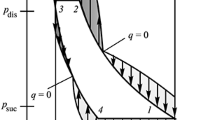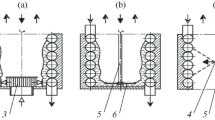Abstract
The study focuses on the development of technology for volumetric noncontact liquid heating based on the dissipative liquid heating effect and realized in a high-gradient flow in the rotor–stator system of a hydrodynamic apparatus. In this paper, the heating performance of a prototype of a rotor-type dissipative liquid heater is studied, and the dynamics of several parameters, such as the heat power generated, the electrical power consumed and the efficiency factor, are defined. It is shown that the time evolution of the efficiency factor along with the other parameters displays a nonlinear character and depends on the flow pattern of the water–vapor system. It is found that the highest efficiency of the dissipative liquid heating of 91.6% is observed in the froth flow of the two-phase water–vapor system. In addition, potential industrial applications of the dissipative liquid heaters are discussed.









Similar content being viewed by others
Notes
Here, the multiplier factor \(\lambda\) represents a property of compressible fluids, similarly to the shear viscosity \(\mu\), and takes into account the energy dissipation due to the volume change of the fluid with finite velocity. It is defined as \(\lambda =-\frac{2}{3}\bullet \mu +{\mu }_{V}\), where \({\mu }_{V}\) is the bulk or volume viscosity of the fluid. The bulk viscosity \({\mu }_{V}\) plays a fundamental role in describing the fluid dynamics of two-phase flows, e.g., bubbly flows. It has also been found that the bulk viscosity of common fluids, such as water, has a higher value than the shear viscosity. For instance, it was reported in [26] that, at 15 °C, the bulk viscosity of water is 3.09·10–3 Pa·s versus the shear viscosity of 1.14·10–3 Pa·s. For more information on the bulk viscosity, we refer to the studies in [27, 28].
Abbreviations
- \(a_{{\text{h}}}\) :
-
Sound velocity in the homogeneous water–vapor mixture (m/s)
- \(a_{{\text{v}}}\) :
-
Sound velocity in the water vapor (m/s)
- \(a_{{\text{w}}}\) :
-
Sound velocity in the water (m/s)
- \(c_{{\text{P}}}^{{\text{s}}}\) :
-
Isobaric specific heat capacity of steel (J/kg K)
- c P :
-
Isobaric specific heat capacity of water (J/kg K)
- d :
-
Diameter of the cylindrical dimples (mm)
- D :
-
External rotor diameter (mm)
- E E :
-
Consumed electrical energy (J)
- \(E_{{\text{E}}}^{{{\text{av}}}}\) :
-
Average value of the electrical energy consumed by the motor drive (active power) during the experiment (W h)
- E H :
-
Generated heat (J)
- H :
-
Depth of the cylindrical dimples (mm)
- h :
-
Rotor width (mm)
- I L :
-
Linear electrical current (A)
- m :
-
Mass of the steel construction of the dissipative liquid heater (kg)
- n :
-
Rotor mechanical speed/rotational speed (rpm)
- P 1 :
-
Inlet gauge pressure (Pa)
- P 2 :
-
Outlet gauge pressure (Pa)
- P S :
-
Saturation water vapor pressure (Pa)
- P St :
-
Static pressure in the annular flow (Pa)
- Q :
-
Water volume flow rate (m3/h)
- R :
-
Radius of the rotor (mm)
- S a :
-
Surface area of the annulus (m2)
- t 1 :
-
Inlet water temperature (°C)
- t 2 :
-
Outlet water temperature (°C)
- Δt S :
-
Temperature rise of the steel construction of the dissipative liquid heater (°C)
- U av :
-
Average peripheral flow velocity in the annulus (m/s)
- U L :
-
Linear electrical voltage (V)
- U m :
-
Maximal peripheral velocity in the annulus (m/s)
- \(U_{{{\text{av}}}}^{{\text{v}}}\) :
-
Average peripheral flow velocity of the vapor phase in the annulus (m/s)
- \(U_{{{\text{av}}}}^{{\text{w}}}\) :
-
Average peripheral flow velocity of the liquid phase in the annulus (m/s)
- V :
-
Annular volume (m3)
- V av :
-
Average axial velocity in the annulus (m/s)
- W DH :
-
Dissipation heat power (W)
- W E :
-
Consumed electrical power (W)
- W H :
-
Generated heat power (W)
- α :
-
Bubble volume fraction
- Δ:
-
Annular breadth (mm)
- η :
-
Efficiency factor
- μ :
-
Dynamic viscosity of the fluid (Pa s)
- ν :
-
Kinematic viscosity of the fluid (m2/s)
- ρ h :
-
Density of the homogeneous water–vapor mixture (kg/m3)
- ρ v :
-
Density of the water vapor (kg/m3)
- ρ w :
-
Water density (kg/m3)
- τ :
-
Operating time (s)
- ω :
-
Angular velocity (radian/s)
- \({\text{Re}}_{{\text{a}}} = \frac{{2 \cdot \delta \cdot V_{{{\text{av}}}} }}{\nu }\) :
-
Reynolds number for the axial flow
- \({\text{Ta}} = \frac{{\omega^{2} \cdot R \cdot \delta^{3} }}{{\nu^{2} }}\) :
-
Taylor number
- AC:
-
Alternating current
- CFD:
-
Computational fluid dynamics
- LMTD:
-
Log-mean temperature difference
- rpm:
-
Rotation per minute
References
Schlichting, H., Gersten, K.: Boundary-Layer Theory, 9th ed. Springer, Berlin (2017). 10.1007/978-3-662-52919-5
Wikipedia: Mechanical Equivalent of Heat. https://en.wikipedia.org/wiki/Mechanical_equivalent_of_heat. Accessed 23 June 2020.
Breido, J., Zyuzev, A., Кalinin, A.: Methods of studying electric-hydrodynamic heater. Energy Procedia. 128, 59–65 (2017). https://doi.org/10.1016/j.egypro.2017.09.015
An alternative to gas boilers: hydrodynamic heater. https://tekmash.org/catalog/goods/95. Accessed 23 June 2020.
Hydrodynamic heat generators. https://ctsystems.ua/?page_id=16. Accessed 23 June 2020.
Kwon, W.C., Yoon, J.Y.: Experimental study of a cavitation heat generator. Proc. Inst. Mech. Eng. Part E J. Process Mech. Eng. 227, 67–73 (2012). https://doi.org/10.1177/0954408912451535
Song, D.B., Kang, B.G.: Heating performance of a heating unit using hydrodynamic cavitation. J. Agric. Life Sci. 50, 203–211 (2016). https://doi.org/10.14397/jals.2016.50.4.203
Pyun, K.B., Kwon, W.C., Oh, K.T., Yoon, J.Y.: Investigation of the performance for a heat generator using hydrodynamic cavitation. In: Proceedings of the ASME-JSME-KSME 2011 Joint Fluids Engineering Conference AJK-Fluids 2011 July 24–29, 2011, Hamamatsu, Shizuoka, JAPAN. Paper No. AJK2011-22045, pp. 701–706. https://doi.org/10.1115/AJK2011-22045
Nikolsky, V., Oliynyk, O., Lipeev, O., Ved, V.: Examining a cavitation heat generator and the control method over the efficiency of its operation. East. Eur. J. Enterpr. Technol. 4, 22–28 (2017). https://doi.org/10.1558/1729-4061.2017.108580
Dyussenov, K.M., Dyussenova, J., Nedugov, I.: The using of controlled cavitation processes in some engineering and agricultural applications. Univ. J. Eng. Sci. 1, 89–94 (2013). https://doi.org/10.13189/ujes.2013.010304
Sun, X., Kang, C.H., Park, J.J., Kim, H.S., Om, A.S., Yoon, J.Y.: An experimental study on the thermal performance of a novel hydrodynamic cavitation reactor. Exp. Therm. Fluid Sci. 99, 200–210 (2018). https://doi.org/10.1016/j.expthermflusci.2018.02.034
Tahmid, S.M., Gill, B.S., Park, K.M., Ryu, Y., Lee, S.: Optimization and testing of a first generation cavitation heat pump. In: Proceeding of the 120th ASEE Annual Conference & Exposition 2013, Atlanta. Paper ID #6649.
US 2005/0051 111A1 Apparatus and method of heating fluids (Christian Helmut Thoma) 10 March 2005. https://patents.google.com/patent/US20050051111A1/en. Accessed 23 June 2020
WO 2008/108596 A1 Method for generating high temperature using cavitation and apparatus thereof (Gun Kie Jung) 12 September 2008. https://patents.google.com/patent/WO2008108596A1/und. Accessed 23 June 2020
Bespalko, S.A.: The Dissipative Heating of Liquid in the Closed Loop System with the Hydrodynamic Heat-Generator. PhD thesis, National Technical University of Ukraine “Kyiv Polytechnic Institute”, Kyiv (2008) (in Ukrainian)
Promtov, M.A.: Rotor-Type Pulsating Apparatuses: Theory and Practice. Mashinostroenie 1, Moscow (2001). (in Russian)
Khalatov, A.A.: Heat Transfer and Fluid Mechanics over Surface Indentations (Dimples). National Academy of Sciences of Ukraine Institute of Engineering Thermophysics, Kyiv (2005)
Moon, H.-K., O'Konnel, T., Glezer, B.: Channel Height Effect on Heat Transfer and Friction in a Dimpled Passage. ASME. 1999. Paper no 99-GT-163.
Moon, S.W., Lau S.C.: Turbulent heat transfer measurements on a wall with concave and cylindrical dimples in a square channel. In: Proceedings of ASME Turbo Expo-48, June 2002, № GT2002–30208, Amsterdam, the Netherlands, pp. 1–9.
Kubanskiy, P.N.: Behavior of resonance system in turbulent flow. Tech. Phys. 27(1), 180–188 (1957). (in Russian)
Dolynskyi, A., Basok, B., Hulyi, S., Nakorchevskyi, A., Shurchkova, Y.: Discrete-Pulse Energy Input in Thermal Technologies. ITTP of the National Academy of Sciences of Ukraine, Kiev (1996). (in Ukrainian)
Monteith, J.L., Unsworth, M.H.: Principles of Environmental Physics, 3rd edn. AP, Amsterdam (2008)
Taylor, G.I.: Stability of a viscous liquid contained between two rotating cylinders. Philos. Trans. R. Soc. Lond. Ser. A 223, 289–293 (1923). https://doi.org/10.1098/rsta.1923.0008
Becker, K.M., Kaye, J.: Measurements of diabatic flow in an annulus with an inner rotating cylinder. J. Heat Transf. 84, 97–104 (1962). https://doi.org/10.1115/1.3684335
Kaye, J., Elgar, E.C.: Modes of adiabatic and diabatic fluid flow in an annulus with an inner rotating cylinder. Trans. ASME. 80, 753–765 (1958)
Litovitz, T.A., Davis, C.M.: Structural and shear relaxation in liquids. Phys. Acoust. 2, 281–349 (1965). https://doi.org/10.1016/B978-1-4832-2858-7.50013-2
Landau, L.D., Lifshitz, E.M.: Course of Theoretical Physics. Volume 6. Fluid Mechanics, vol. 2. Pergamon Press, New York (1987)
Graves, R.E., Argrow, B.M.: Bulk viscosity: past to present. J. Thermophys. Heat Transfer 13, 337–342 (1999). https://doi.org/10.2514/2.6443
Nigmatulin, R.I.: Dynamics of Multiphase Media, vol. 1. CRC Press, Boca Raton (1990)
Tadmor, E.B., Miller, R.E., Elliott, R.S.: Continuum Mechanics and Thermodynamics: From Fundamental Concepts to Governing Equations. Cambridge University Press, Cambridge (2011)
Richter, H.J.: Separated two-phase flow model: application to critical two-phase flow. Int. J. Multiphase Flow. 9, 511–530 (1983). https://doi.org/10.1016/0301-9322(83)90015-0
Sommerfeld, M.: Numerical Methods for Dispersed Multiphase Flows. Chapter in the book Particles in Flows. Springer, Berlin (2017). https://doi.org/10.1007/978-3-319-60282-0
Ghiaasiaan, S.: Choking in two-phase flow. In Two-Phase Flow, Boiling, and Condensation: In Conventional and Miniature Systems. Cambridge University Press, Cambridge, pp. 643–677 (2017). https://doi.org/10.1017/9781316597392.019
Loitsyansky, L.G.: Fluid and Gas Mechanics, 7th edn. Drofa, Moscow (2003)
Cerecedo, L.M., Dopazo, C., Gomez-Lus, R.: Water disinfection by hydrodynamic cavitation in a rotor-stator device. Ultrason. Sonochem. 48, 71–78 (2018). https://doi.org/10.1016/j.ultsonch.2018.05.015
Dindar, E.: An overview of the application of hydrodinamic cavitation for the intensification of wastewater treatment applications: a review. Innov. Energy Res. 5, 137 (2016). https://doi.org/10.4172/2576-1463.1000137
Gągol, M., Przyjazny, A., Boczkaj, G.: Wastewater treatment by means of advanced oxidation processes based on cavitation—a review. Chem. Eng. J. 338, 599–627 (2018). https://doi.org/10.1016/j.cej.2018.01.049
Lee, T.-W.: Thermal and Flow Measurements, p. 400. CRC Press, Taylor & Francis Group, Boca Raton (2008)
Acknowledgements
The authors would like to thank the administration of Shpola REM PJSC "Cherkasyoblenergo" (Ukraine) for permission to conduct our experiments and test the heating performance of the rotor-type dissipative liquid heater.
Author information
Authors and Affiliations
Corresponding author
Ethics declarations
Conflict of interest
On behalf of all authors, the corresponding author states that there is no conflict of interest.
Additional information
Publisher's Note
Springer Nature remains neutral with regard to jurisdictional claims in published maps and institutional affiliations.
Appendix: Measuring instrument description and uncertainty analysis
Appendix: Measuring instrument description and uncertainty analysis
Measuring instrument description
Description of the tools used for direct measurements of the hydraulic, thermal, and electrical parameters is presented in Table
3.
Uncertainty analysis
The uncertainty analysis of the measured and calculated parameters was carried out based on the error propagation theory as described by Lee [38]. Table
4 contains total uncertainties of the measured parameters.
Consumed electrical power
The uncertainty of the consumed electrical power ΔWE can be found as follows:
where ΔIL is the total uncertainty of the linear electrical current measured, ΔUL is the total uncertainty of the linear voltage measured.
Generated heat power
The uncertainty of the generated heat power ΔWH can be calculated as given below:
where ΔQ is the total uncertainty of the water volume flow rate measured, Δρ is the total uncertainty of the water density calculated, ΔcP is the total uncertainty of the water isobaric specific heat capacity calculated, Δt2 is the total uncertainty of the outlet water temperature measured, Δt1 is the total uncertainty of the inlet water temperature measured.
Efficiency factor
The uncertainty of the efficiency factor Δη can be estimated as follows:
where ΔWH is the total uncertainty of the heat power calculated, ΔWE is the total uncertainty of the electrical power calculated.
Table
5 presents the total uncertainties of the calculated parameters.
Rights and permissions
About this article
Cite this article
Bespalko, S., Halychyi, O., Yovchenko, A. et al. Experimental testing of the heating performance of a rotor-type dissipative liquid heater. Int J Energy Environ Eng 12, 39–54 (2021). https://doi.org/10.1007/s40095-020-00354-0
Received:
Accepted:
Published:
Issue Date:
DOI: https://doi.org/10.1007/s40095-020-00354-0




